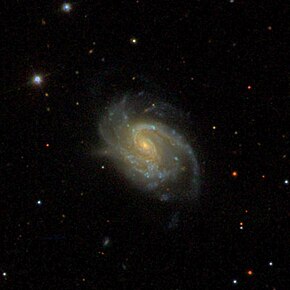| NGC 132 | |
|---|---|
 NGC 132 imaged by SDSS | |
| Observation data (J2000 epoch) | |
| Constellation | Cetus |
| Right ascension | 00h 30m 10.7123s[1] |
| Declination | +02° 05′ 36.497″[1] |
| Redshift | 0.017892[1] |
| Heliocentric radial velocity | 5364 ± 4 km/s[1] |
| Distance | 241.3 ± 16.9 Mly (73.97 ± 5.19 Mpc) |
| Apparent magnitude (V) | 13.45[1] |
| Characteristics | |
| Type | SAB(s)bc[2] |
| Size | ~139,000 ly (42.61 kpc) (estimated)[1] |
| Apparent size (V) | 1.95′ × 1.3′[2] |
| Other designations | |
| IRAS 00276+0149, UGC 301, MCG +00-02-063, PGC 1844, CGCG 383-032[1] | |
NGC 132 is a spiral galaxy in the constellation Cetus. Its velocity with respect to the cosmic microwave background is 5015 ± 25 km/s, which corresponds to a Hubble distance of 241.3 ± 16.9 Mly (73.97 ± 5.19 Mpc).[1] In addition, three non redshift measurements give a distance of 250.81 ± 2.14 Mly (76.900 ± 0.656 Mpc).[3] It was discovered on 25 December 1790 by German-British astronomer William Herschel.[2]
One supernova has been observed in NGC 132: SN 2004fe (type Ic, mag. 18.1) was discovered on October 30, 2004.[4][5]
- ^ a b c d e f g h "NED Results for the object NGC 0132". NASA/IPAC Extragalactic Database. Retrieved 21 March 2016.
- ^ a b c "New General Catalogue Objects: NGC 100-149 - NGC 132". Seligman, Courtney. Retrieved 21 March 2016.
- ^ "Distance Results for NGC 132". NASA/IPAC EXTRAGALACTIC DATABASE. NASA. Retrieved 20 September 2024.
- ^ Pugh, H.; et al. (November 2004). Green, D. W. E. (ed.). "Supernovae 2004fe, 2004ff, 2004fg". IAU Circular. 8425 (1): 1. Bibcode:2004IAUC.8425....1P.
- ^ "SN 2004fe". Transient Name Server. IAU. Retrieved 20 September 2024.